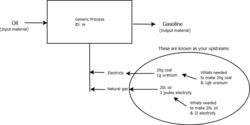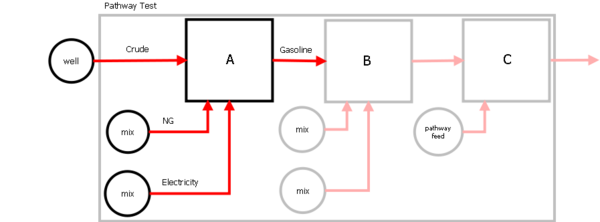Calculations For General Processes
Basic Principle of a Process
A fundamental concept of the GREET model is the "Process". A process is an abstract representation of what is needed to produce something else. For example there could be a process to represent the production of gasoline from oil. A basic process is shown below.

The Figure to the right represents a process that takes in oil and creates gasoline. In this process oil is your input material. However, in addition to oil it will take electricity and some natural gas to produce this gasoline. For simplicities sake you can view oil, natural gas, and electricity as the inputs you would need in this process to get the desired output. The natural gas and electricity are known as the process fuels or inputs of the process.
In addition to simply looking at these inputs at face value GREET goes into further detail. It looks at what is needed to produce these inputs. These are known as upstreams. If you look at the figure above you can see that electricity will be produced by burning 20g of coal and utilizing 1g of uranium. In addition Natural gas will be created by using 20L of oil and 3 joules of electricity. After deducing this the GREET model will actually trace back the 20g of coal, 1g of uranium, 20L of oil, and 3 joules of electricity to see how they are produced. It will continue to do this until electricity and natural gas are broken down into the most basic of materials. By doing this the GREET model can analyze the total amount of energy consumed and emissions produced to create a certain type of fuel. This data tells the user how utilizing this specific fuel effects the world on a life cycle level.
Balance of a Process
Below is a slight modified representation of the previous diagram to show a little bit more how the balance is working :
We are going to only take care of the process . This process is a very simplified version of a "crude extraction/refinery" process which produce gasoline from crude oil. The process have three different inputs, two of them are coming from Sources and the other is coming from the well. It means that we'll have some upstream for two of them, but no upstream will be accounted for the crude. The balance in that case will be simply calculated that way : -
This equation shows the Amounts vector which is representing what was necessary to produce one unit of output. The vector sums up all the inputs amounts + their upstream if there is any. I the case of crude oil, there is no upstream as it comes from a well. Then we divide that overall input amount by the amount obtained on the main output.
This balance vector will be used by the next process as the upstream for the input coming from "previous", from process to process, pathways to pathways, Sources to Sources, this Ep vector will always be propagated in order to represent whatever was necessary as an input to get one unit of an output. At the end of the calculations those will represent the results.
During any operations on that vector, all quantities are regrouped by materials, and if different amounts of the same materials are added, they will be automatically converted into Joules. Therefore in the results we will see energy quantities for most of the materials, except the ones that cannot be converted to an energy amount ( lack of information for that material i.e. Heating Value, Density... )
Types of Processes in GREET
The fundamental concept of a process is very broad. In GREET.net we have defined three main types of processes: stationary, transportation and storage processes. The example processes in the previous sections are all stationary processes. Below are the formal definitions of the three types of processes used in GREET.net.
